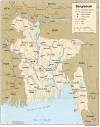Investigation on Anthrax in Bangladesh during the Outbreaks of 2011 and Definition of the Epidemiological Correlations
- PMID: 33921040
- PMCID: PMC8071373
- DOI: 10.3390/pathogens10040481
Investigation on Anthrax in Bangladesh during the Outbreaks of 2011 and Definition of the Epidemiological Correlations
Abstract
In 2011, in Bangladesh, 11 anthrax outbreaks occurred in six districts of the country. Different types of samples were collected from May to September in the six districts where anthrax had occurred in order to detect and type Bacillus anthracis (B. anthracis) strains. Anthrax was detected in 46.6% of the samples analysed, in particular in soils, but also in bone samples, water, animal feed, and rumen ingesta of dead animals. Canonical single nucleotide polymorphisms (CanSNPs) analysis showed that all the isolates belonged to the major lineage A, sublineage A.Br.001/002 of China and Southeast Asia while the multi-locus variable number of tandem repeats (VNTRs) analysis (MLVA) with 15 VNTRs demonstrated the presence of five genotypes, of which two resulted to be new genotypes. The single nucleotide repeats (SNRs) analysis showed 13 SNR types; nevertheless, due to its higher discriminatory power, the presence of two isolates with different SNR-type polymorphisms was detected within two MLVA genotypes. This study assumes that soil is not the only reason for the spread of the disease in Bangladesh; contaminated feed and water can also play an important role in the epidemiology of anthrax. Possible explanations for these epidemiological relationships are discussed.
Keywords: Bacillus anthracis; Bangladesh; MLVA; epidemiology; food contamination.
Conflict of interest statement
The authors declare no conflict of interest.
Figures

Similar articles
-
Bangladesh anthrax outbreaks are probably caused by contaminated livestock feed.Epidemiol Infect. 2013 May;141(5):1021-8. doi: 10.1017/S0950268812001227. Epub 2012 Jul 20. Epidemiol Infect. 2013. PMID: 22814512 Free PMC article.
-
Genotype Analysis of Bacillus anthracis Strains Circulating in Bangladesh.PLoS One. 2016 Apr 15;11(4):e0153548. doi: 10.1371/journal.pone.0153548. eCollection 2016. PLoS One. 2016. PMID: 27082248 Free PMC article.
-
Genotyping and population diversity of Bacillus anthracis in China based on MLVA and canSNP analysis.Microbiol Res. 2020 Mar;233:126414. doi: 10.1016/j.micres.2020.126414. Epub 2020 Jan 15. Microbiol Res. 2020. PMID: 31981903
-
Bacillus anthracis: molecular taxonomy, population genetics, phylogeny and patho-evolution.Infect Genet Evol. 2011 Aug;11(6):1218-24. doi: 10.1016/j.meegid.2011.05.013. Epub 2011 May 27. Infect Genet Evol. 2011. PMID: 21640849 Review.
-
Bacillus anthracis evolution and epidemiology.Curr Top Microbiol Immunol. 2002;271:21-32. doi: 10.1007/978-3-662-05767-4_2. Curr Top Microbiol Immunol. 2002. PMID: 12224522 Review.
Cited by
-
Animal, human, and environmental perspectives on anthrax in Bangladesh.Heliyon. 2023 Dec 9;10(1):e23481. doi: 10.1016/j.heliyon.2023.e23481. eCollection 2024 Jan 15. Heliyon. 2023. PMID: 38192846 Free PMC article.
-
Human Anthrax: Update of the Diagnosis and Treatment.Diagnostics (Basel). 2023 Mar 10;13(6):1056. doi: 10.3390/diagnostics13061056. Diagnostics (Basel). 2023. PMID: 36980364 Free PMC article. Review.
References
-
- Lewerin S.S., Elvander M., Westermark T., Hartzell L.N., Norström A.K., Ehrs S., Knutsson R., Englund S., Andersson A.C., Granberg M., et al. Anthrax outbreak in a Swedish beef cattle herd-1st case in 27 years: Case report. Acta Vet. Scand. 2010;52:7. doi: 10.1186/1751-0147-52-7. - DOI - PMC - PubMed
LinkOut - more resources
Full Text Sources
Other Literature Sources


